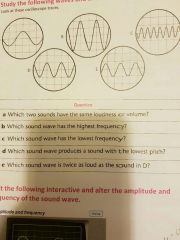![]()
![]()
![]()
Use LEFT and RIGHT arrow keys to navigate between flashcards;
Use UP and DOWN arrow keys to flip the card;
H to show hint;
A reads text to speech;
15 Cards in this Set
- Front
- Back
|
Transverse waves |
Vibrations are at right angles to the direction of travel and energy transfer |
|
|
Longitudinal waves |
Oscillations are along the same direction of travel and energy transfer |
|
|
Static electricity |
Electricity that gets collected on the surface of something and does not flow as a current |
|
|
Current electricity |
The movement of charge through an electric circuit |
|
|
Aplitude |
Loudness...the greater the amplitude the louder the sound |
|
|
Frequency |

The greater the frequency the higher the pitch Numbef of waves produced by a source each second. Measured in hertz (Hz) |
|
|
Wavelength |
Distance between a point on one wave and the same point on the next wave. Wave speed= frequency × wavelength |
|
|
Conductors |
Materials that allow flow of electrons on their surfaces. E.g- copper..iron platinum |
|
|
Insulators |
Materials that do not allow electrons to flow through them e.g- plastic rubber wool |
|
|
Compression |
Region in a longitudinal wave where the particles are closest together |
|
|
Rarefaction |
Region in the longitudinal wave where the particles are furthest apart |
|
|
Resistance |
How easily electrons can flow through a conductor |
|
|
Component |
Anything in an electrical circuit is called a component |
|
|
Ohms law |
V= I × R |
|
|
Measuring units |
Voltage...volts Current....amperes amps A Resistance ohms Frequency....hertz Wavelength....metres |

